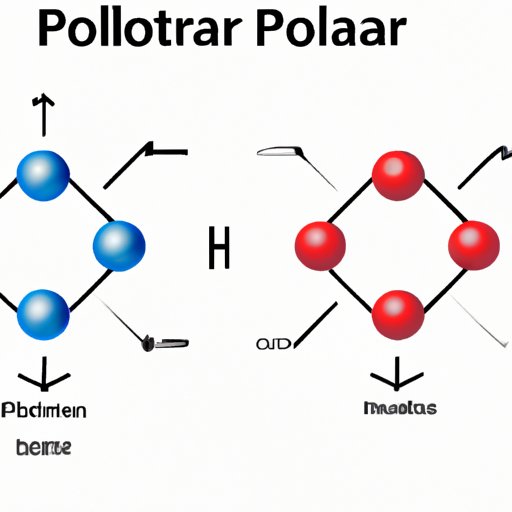Introduction
Water is an essential component of our world, and we often encounter it in its different forms – from oceans, lakes and rivers to ice and snow. The unique and diverse properties of water play an integral role in supporting life and sustaining the environment. One of the most important and intriguing properties of water is its ability to behave as a polar molecule. In this article, we will explore why water is considered to be a polar molecule in depth. This article is targeted towards students, educators, and individuals who are interested in learning more about the science behind water’s behavior.
Breaking Down the Polar Nature of Water: Exploring the Science Behind Its Unique Properties
To understand the concept of a polar molecule, we must first differentiate it from a non-polar molecule. An atom’s ability to attract electrons is known as electronegativity, and the difference in electronegativity between atoms in a molecule determines whether it is polar or non-polar. When one end of a molecule has a partial positive charge, and the other end has a partial negative charge due to the uneven distribution of valence electrons, it is known as a polar molecule. In contrast, if the valence electrons are distributed evenly across the molecule, it is non-polar.
Water is unique because it is a highly polar molecule due to its bent shape, with oxygen at the center and two hydrogen atoms at either end. The oxygen atom is more electronegative than the hydrogen atoms, which leads to an unequal sharing of electrons, resulting in a partial negative charge on the oxygen atom and a partial positive charge on the hydrogen atoms.
These partial charges lead to some unique properties of water, such as its ability to form hydrogen bonds, which give it a high surface tension and adhesion to other surfaces.
Why Water Behaves Differently: Understanding the Polar Molecule Concept
The electronegativity of an atom is a measure of its ability to attract electrons in a covalent bond. In a water molecule, the oxygen atom is more electronegative than the hydrogen atoms, pulling the shared electrons in the covalent bonds closer to itself. This unequal distribution of electrons gives the oxygen atom a partially negative charge (-δ), and the hydrogen atoms a partially positive charge (+δ). This bond’s distribution creates a dipole moment, which contributes to the water molecule’s polarity.
The bent shape of the water molecule also contributes to its polarity. The oxygen atom is at the center of the molecule and pulls the electrons closer to each other, resulting in the asymmetric distribution of the charges. The polarity and shape of water molecules lead to the formation of hydrogen bonds, which are responsible for its unique properties.
The Importance of Polarity in Water: What Makes it Unique in the World of Liquids
Polarity plays a crucial role in the physical and chemical characteristics of liquids. In general, polar liquids have a higher boiling point, higher surface tension, and better solubility in water than non-polar liquids. For example, when we pour vinegar into water, the polar nature of water enables it to dissolve the polar acetic acid present in the vinegar. However, the non-polar oils do not dissolve in water and instead float on top of it.
Water’s polarity is also responsible for its high heat capacity, which allows it to absorb and release heat energy slowly. It is also responsible for its ability to stick to other polar surfaces, such as glass. This adhesive property of water allows trees and plants to transport water from the roots to the leaves.
A Closer Look at Hydrogen Bonding in Water and Its Role in Making It a Polar Molecule
Hydrogen bonding is a unique type of attraction between the partial positive charge on the hydrogen atoms of one molecule and the partial negative charge on the oxygen atom of another molecule. In the case of water, hydrogen bonding occurs between the hydrogen atom of one water molecule and the oxygen atom of another water molecule. Due to the strong polarization of the water molecule, the hydrogen bond that is formed is relatively strong, which contributes to water’s high boiling point.
Hydrogen bonds give water its unique properties, such as its high surface tension, which allows it to resist external forces like gravity. This property is responsible for capillary action, where water moves upwards through tiny tubes like the xylem in plants. Hydrogen bonding also ensures that water remains a liquid at Earth’s surface temperatures.
Exploring the Chemistry of Water: Understanding How Its Polar Nature Makes Life Possible
Water is an essential component for life, and its polarity plays a crucial role in cellular function. Its dipole moment allows it to interact with other polar molecules like proteins and carbohydrates. The polar nature of water is why it can dissolve a wide range of substances, making it the universal solvent for biological processes. It creates a medium for metabolic reactions to take place and allows for the transport of nutrients throughout the body.
Water’s polarity also allows it to participate in crucial biological processes like osmosis and helps regulate body temperature. The cooling effect of sweating occurs due to the evaporation of sweat, which is possible due to water’s high heat of vaporization, another property that arises from the polarity of water.
Conclusion
Water’s unique properties are what make it an essential component of life on Earth. Its ability to behave as a polar molecule is responsible for various environmental and physical phenomena. Understanding water’s polarity and hydrogen bonding is crucial in fields like chemistry, biology, and environmental science. Further research in this area will provide a better understanding of water’s behavior, aid in environmental conservation efforts and contribute to technological advancements.
We hope that this article has provided you with a better insight into the science behind water’s polar nature and its significance in our world.
